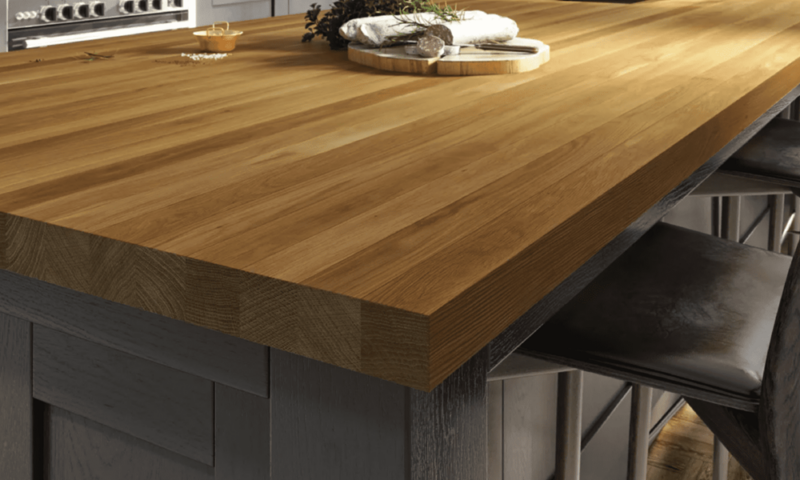Help and Advice, How To
The Complete Guide to Maintaining and Caring for Your Wooden Kitchen Worktop
Wooden kitchen worktops are a stunning addition to any kitchen, blending natural beauty with exceptional durability. However, to keep them looking their best, proper care and maintenance are essential. Whether you’re already the proud owner of a wood worktop or considering purchasing one, this guide will give you all the information you need to ensure it stays in great condition.
Daily Cleaning of your Wood Worktop
Keeping your wood worktop clean is the first step in maintaining its charm and longevity. Follow these simple tips for daily upkeep:
- Use Gentle Tools: Opt for soft cloths or sponges to wipe down the surface. Harsh scrubbing tools can scratch and damage the finish.
- Choose Mild Detergents: Stick to gentle, non-abrasive cleaners mixed with warm water. Harsh chemicals can strip the wood of its natural oils, leaving it dry and vulnerable.
- Avoid Excess Moisture: After cleaning, ensure the worktop is thoroughly dried to prevent water absorption.
Looking for premium-quality wooden worktops? Explore our stunning range of wood kitchen worktops to find the perfect fit for your home.
Preventing Water Damage
Wood is porous, which means prolonged contact with water can lead to warping or staining. Here’s how to keep water damage at bay:
- Clean Spills Quickly: Always wipe up spills as soon as they occur.
- Use Mats and Coasters: Place mats under dishes and use coasters with glasses to shield the surface from water rings and heat damage.
- Pay Attention to Sinks: Ensure the area around sinks is kept dry and regularly checked for any signs of water damage.
Regular Oiling and Sealing
Oiling and sealing your wood worktop helps it resist wear and tear while maintaining its rich finish. Follow this step-by-step guide:
- Choose the Right Oil: Danish oil, tung oil, or food-safe mineral oil are popular options.
- Prepare the Surface: Clean the worktop and let it dry completely.
- Apply the Oil: Using a lint-free cloth, rub the oil in the direction of the wood grain.
- Let It Absorb: Allow the oil to soak in for several hours or overnight.
- Buff the Surface: Use a clean cloth to remove excess oil and polish the surface.
Frequency depends on usage, but a good rule of thumb is to re-oil every 3–6 months.
Dealing with Stains and Scratches
Wood worktops can be prone to minor blemishes, but most can be fixed with simple remedies:
- Removing Stains: For food or drink stains, try a paste of baking soda and water. Gently rub it into the stain and wipe away.
- Sanding Scratches: Use fine-grit sandpaper to lightly sand the area, following the wood grain. Reapply oil to restore the finish.
For more stubborn marks, consult a professional to avoid causing further damage.
Avoiding Direct Heat: Protect Your Worktop!
Heat is a common culprit of damage to wood worktops. To avoid issues:
- Always use trivets or heat pads under hot pots and pans.
- Never place heated appliances, such as kettles or toasters, directly onto the wood.
Preventing Cuts and Scratches
While wood is durable, it’s not immune to cuts or scratches:
- Always Use Cutting Boards: Never chop food directly on your worktop.
- Inspect Regularly: Check for minor nicks or scratches and address them promptly to prevent further damage.
Long-Term Maintenance: Keeping Your Worktop Looking Like New
Over time, your worktop may require more intensive care:
- Re-sanding: For heavily worn or damaged surfaces, sanding the entire worktop can restore its beauty.
- Professional Help: For deep gouges or extensive wear, hiring a professional ensures proper restoration.
Seasonal Care: Adapting to Weather Changes
Wood naturally expands and contracts with changes in temperature and humidity. To minimise seasonal impacts:
- Use a humidifier in winter to prevent drying.
- Avoid placing worktops near radiators or direct sunlight.
Common Mistakes to Avoid
Avoid these pitfalls to ensure your worktop remains in top condition:
- Using harsh chemical cleaners.
- Allowing spills to sit for extended periods.
- Exposing the surface to prolonged sunlight.
FAQs About Wood Worktop Maintenance
Q: How often should I oil my wood worktop?
A: For heavily used surfaces, oil every 3 months. For less frequently used worktops, every 6 months should suffice.
Q: Can I use bleach on my wood worktop?
A: No, bleach can damage the wood’s finish and natural oils. Stick to mild, non-abrasive cleaners.
Q: What’s the best way to remove water rings?
A: Lightly sand the affected area with fine-grit sandpaper, then re-oil to restore the finish.
Proper maintenance is the key to enjoying the natural beauty of your wood kitchen worktop for years to come. By following these tips, you’ll protect your investment and keep your kitchen looking stunning.
For more expert advice and a wide selection of high-quality kitchen worktops, contact Kitchen Worktops Online.



















